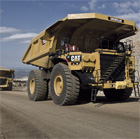Regulatory regime discourages investment in new mining projects
By Mark Fellows
The Hill
 There’s no shortage of positive news regarding manufacturing’s triumphant return to American shores: General Electric plans to open its seventh U.S. jet engine assembly factory in just seven years; Tesla’s deciding between four states to house the world’s largest lithium-ion battery factory; and Apple is close to finalizing its sapphire glass manufacturing plant in Arizona, just to name a few. This resurgence will continue to reap much-needed rewards ranging from job growth and economic expansion to increased U.S. competitiveness and national security. Yet, there remains one large unknown to “reshoring” success: could domestic manufacturing operations benefit from domestic mineral reserves or will they continue to rely on foreign imports for their raw material needs?
There’s no shortage of positive news regarding manufacturing’s triumphant return to American shores: General Electric plans to open its seventh U.S. jet engine assembly factory in just seven years; Tesla’s deciding between four states to house the world’s largest lithium-ion battery factory; and Apple is close to finalizing its sapphire glass manufacturing plant in Arizona, just to name a few. This resurgence will continue to reap much-needed rewards ranging from job growth and economic expansion to increased U.S. competitiveness and national security. Yet, there remains one large unknown to “reshoring” success: could domestic manufacturing operations benefit from domestic mineral reserves or will they continue to rely on foreign imports for their raw material needs?
With $6.2 trillion worth of mineral and metal reserves, a diverse base of raw materials would seem yet another attractive benefit of relocating manufacturing operations to the United States. Domestic mineral reserves include copper, nickel, lithium, iron ore, gold, potash, silver, platinum group metals and many others — inputs that are essential to the manufacture of cutting-edge technologies, advanced energy components and defense equipment. The utilization of these domestically-sourced minerals could shorten manufacturers’ supply chains, reduce logistical and transportation costs, ensure environmental and social accountability of sourced materials, and better cushion companies against disruption risks.
